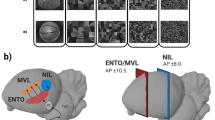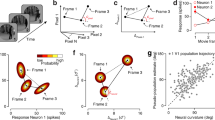Abstract
Three types of looming-selective neurons have been found in the nucleus rotundus of pigeons, each computing a different optical variable related to image expansion of objects approaching on a direct collision course with the bird. None of these neurons respond to simulated approach toward stationary objects. A detailed analysis of these neurons' firing pattern to approaching objects of different sizes and velocities shows that one group of neurons signals relative rate of expansion τ (tau), a second group signals absolute rate of expansion ρ (rho), and a third group signals yet another optical variable η (eta). The ρ parameter is required for the computation of both τ and η, whose respective ecological functions probably provide precise 'time-to-collision' information and 'early warning' detection for large approaching objects.
This is a preview of subscription content, access via your institution
Access options
Subscribe to this journal
Receive 12 print issues and online access
$209.00 per year
only $17.42 per issue
Buy this article
- Purchase on Springer Link
- Instant access to full article PDF
Prices may be subject to local taxes which are calculated during checkout




Similar content being viewed by others
References
Gibson, J. J. The Senses Considered as Perceptual Systems (Houghton Mifflin, Boston, 1966).
Gibson, J. J. The Ecological Approach to Visual Perception (Houghton Mifflin, Boston, 1979).
Nakayama, K. & Loomis, J. M. Optical velocity patterns, velocity-sensitive neurons and space perception: a hypothesis. Perception 3, 63–80 (1974).
Frost, B. J., Wylie, D. R. & Wang, Y.-C. in Perception and Motor Control in Birds (eds Davies, M. N. O. & Green, P. R.) 248–269 (Springer-Verlag, Berlin, 1994).
Longuet-Higgins, H. C. & Prazdny, K. The interpretation of moving retinal image. Proc. R. Soc. Lond. B 206, 358– 397 (1980).
Wylie, D. R., Kripalani, T. & Frost, B. J. Responses of pigeon vestibulocerebellar neurons to optokinetic stimulation. I. Functional organization of neurons discriminating between translational and rotational visual flow. J. Neurophysiol. 70, 2632–2646 (1993).
Roy, J.-P. & Wurtz, R. H. The role of disparity-sensitive cortical neurons in signalling the direction of self-motion. Nature 348, 160–162 ( 1990).
Tanaka, K. & Saito, H. Analysis of motion of the visual field by direction, expansion/contraction, and rotation cells clustered in the dorsal part of the medial superior temporal area of the Macaque Monkey. J. Neurophysiol. 62, 626–641 (1989).
Schiff, W. Perception of impending collision: A study of visually directed avoidant behaviour. Psychol. Monogr. 79, 1–26 (1965).
Dill, L. M. The escape response of the zebra danio (Brachydanio rerio). I. The stimulus for escape. Anim. Behav. 22, 771–722 (1974).
Ingle, D. J. & Shook, B. L. in Brain Mechanisms of Spatial Vision (eds Ingle, D. J., Jeannerod, M. & Lee, D. N.) 229– 258 (Martinus Nijhoft, Dordrecht, 1985).
Hayes, W. N. & Saiff, E. I. Visual alarm reactions in turtles . Anim. Behav. 15, 102– 108 (1967).
Tronick, E. Approach response of domestic chicks to an optical display. J. Comp. Physiol. Psychol. 64, 529–531 ( 1967).
Schiff, W., Caviness, J. A. & Gibson, J. J. Persistent fear responses in rhesus monkeys to the optical stimulus of 'looming'. Science 136, 982– 983 (1962).
Bower, T. G. R., Broughton, J. M. & Moore, M. K. Infant responses to approaching objects: an indicator of response to distal variables. Percept. Psychophys. 9, 193–196 (1970).
Ball, W. & Tronick, E. Infant responses to impending collision . Science 171, 818–820 (1971).
Lee, D. N. A theory of visual control of braking based on information about time-to-collision. Perception 5, 437–459 ( 1976).
Lee, D. N. The optic flow field: The foundation of vision. Philos. Trans. R. Soc. Lond. B Biol. Sci. 290, 169–179 (1980).
Lee, D. N., & Reddish, P. E. Plummeting gannets: a paradigm of ecological optics. Nature 293, 293– 294 (1980).
Lee, D. N., & Reddish, P. E. Visual regulation of gait in long jumping. J. Exp. Psychol. Hum. Percept. Perform. 8, 448–459 (1982).
Sun, H.-J., Carey, D. P. & Goodale, M. A. A mammalian model of optic-flow utilization in the control of locomotion. Exp. Brain Res. 91, 171– 175 (1992).
Wagner, H. Flow-field variables trigger landing in flies. Nature 297, 147 –148 (1982).
Lee, D. N. & Young, D. S. in Brain Mechanisms and Spatial Vision (eds Ingle, D. J., Jeannerod, M. & Lee, D. N.) 1– 30 (Martinus Nijhoff, Dordrecht, 1985).
Regan, D. & Hamstra, S. J. Dissociation of discrimination thresholds for time to contact and for rate of angular expansion. Vision Res. 33, 447–462 (1993).
Tresilian, J. R. Four questions of time to contact: A critical examination of research on interceptive timing . Perception 22, 653–680 (1993).
Wann, J. P. Anticipating arrival: Is the tau margin a specious theory? J. Exp. Psychol. Hum. Percept. Perform. 22, 1031–1048 (1996).
Rind, F. C. & Simmons, P. J. Orthopteran DCMD neuron: A reevaluation of responses to moving objects. I. Selective responses to approaching objects . J. Neurophysiol. 68, 1654– 1666 (1992).
Simmons, P. J. & Rind, F. C. Orthopteran DCMD neuron: A reevaluation of responses to moving objects. II. Critical cues for detecting approaching objects. J. Neurophysiol. 68, 1667– 1682 (1992).
Hatsopoulos, N., Gabbiani, F. & Laurent, G. Elementary computation of object approach by a wide-field visual neuron. Science 270, 1000– 1003 (1995).
Wang, Y. & Frost, B. J. Time to collision is signalled by neurons in the nucleus rotundus of pigeons. Nature 356, 236–238 (1992).
Wang, Y. C., Jiang, S. & Frost, B. J. Visual processing in pigeon nucleus rotundus: luminance, colour, motion and looming subdivisions. Visual Neurosci. 10, 21–31 (1993).
Frost, B. J. & Sun, H.-J. in From Living Eyes to Seeing Machines (eds Srinivasan, M. V. & Venkatesh, S.) 80– 103 (Oxford Univ. Press, Oxford, 1997).
DeLucia, P. R. Pictorial and motion-based information for depth perception. J. Exp. Psychol. Hum. Percept. Perform. 17, 738–748 (1991).
Robertson, R. M. & Johnson, A. G. Retinal image size triggers obstacle avoidance in flying locusts. Naturwissenschaften 80 , 176–178 (1993).
Acknowledgements
The authors wish to thank T. Kripalani and S. David for excellent technical assistance and D. Fleet and N. Troje for helpful discussions and comments on the manuscripts. HJS was supported by a Postgraduate Scholarship from the Natural Science and Engineering Research Council (NSERC) of Canada. This work was supported by an NSERC grant OGP0000353 and an Alexander von Humboldt Research Award to BJF.
Author information
Authors and Affiliations
Rights and permissions
About this article
Cite this article
Sun, H., Frost, B. Computation of different optical variables of looming objects in pigeon nucleus rotundus neurons. Nat Neurosci 1, 296–303 (1998). https://doi.org/10.1038/1110
Received:
Accepted:
Issue Date:
DOI: https://doi.org/10.1038/1110
This article is cited by
-
Neural Circuit Mechanisms Involved in Animals’ Detection of and Response to Visual Threats
Neuroscience Bulletin (2023)
-
Oscillatory biomarkers of autism: evidence from the innate visual fear evoking paradigm
Cognitive Neurodynamics (2023)
-
Approaching object acceleration differentially affects the predictions of neuronal collision avoidance models
Biological Cybernetics (2023)
-
From the eye to the wing: neural circuits for transforming optic flow into motor output in avian flight
Journal of Comparative Physiology A (2023)
-
Embodiment and cognitive neuroscience: the forgotten tales
Phenomenology and the Cognitive Sciences (2022)



